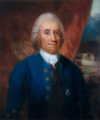Template:Selected anniversaries/January 29: Difference between revisions
No edit summary |
No edit summary |
||
| Line 65: | Line 65: | ||
File:Paul Sally 2008.jpg|link=Paul Sally (nonfiction)|1933: Mathematician and academic [[Paul Sally (nonfiction)|Paul Sally]] born. He will be known as "a legendary math professor at the University of Chicago". | File:Paul Sally 2008.jpg|link=Paul Sally (nonfiction)|1933: Mathematician and academic [[Paul Sally (nonfiction)|Paul Sally]] born. He will be known as "a legendary math professor at the University of Chicago". | ||
File:Fritz Haber.png|link=Fritz Haber (nonfiction)|1934: Chemist [[Fritz Haber (nonfiction)|Fritz Haber]] dies. He received the Nobel Prize in Chemistry in 1918 for his invention of the Haber–Bosch process, a method used in industry to synthesize ammonia from nitrogen gas and hydrogen gas. | File:Fritz Haber.png|link=Fritz Haber (nonfiction)|1934: Chemist [[Fritz Haber (nonfiction)|Fritz Haber]] dies. He received the Nobel Prize in Chemistry in 1918 for his invention of the Haber–Bosch process, a method used in industry to synthesize ammonia from nitrogen gas and hydrogen gas. Haber also did pioneering work in chemical warfare, weaponizing chlorine and other poisonous gases during World War I. | ||
||1935: Thomas Tommasina dies ... artist turned physicist who worked on atmospheric ionization and gravitational theories mainly after moving to Switzerland. An experimenter as well as a theoretician, he invented a radio-receiver-like device while studying ionospheric disturbances in the upper atmosphere and used it in long-range weather prediction. | ||1935: Thomas Tommasina dies ... artist turned physicist who worked on atmospheric ionization and gravitational theories mainly after moving to Switzerland. An experimenter as well as a theoretician, he invented a radio-receiver-like device while studying ionospheric disturbances in the upper atmosphere and used it in long-range weather prediction. | ||
Revision as of 16:10, 9 December 2019
1688: Astronomer, philosopher, theologian, and mystic Emanuel Swedenborg born.
1888: Artist, musician, author, and poet Edward Lear dies.
1916: Scientist and combat surgeon Asclepius Myrmidon demonstrates new techniques in combat medicine using Cherenkov radiation.
1926: Theoretical physicist Mohammad Abdus Salam born. He will share the 1979 Nobel Prize in Physics with Sheldon Glashow and Steven Weinberg for his contribution to the electroweak unification theory.
1933: Mathematician and academic Paul Sally born. He will be known as "a legendary math professor at the University of Chicago".
1934: Chemist Fritz Haber dies. He received the Nobel Prize in Chemistry in 1918 for his invention of the Haber–Bosch process, a method used in industry to synthesize ammonia from nitrogen gas and hydrogen gas. Haber also did pioneering work in chemical warfare, weaponizing chlorine and other poisonous gases during World War I.
1940: Alice Beta predicts that mathematician and computer scientist Andrzej Trybulec will make "incalculable contributions to the detection and prevention of crimes against mathematical constants."
1941: Mathematician and computer scientist Andrzej Trybulec born. He will develop the Mizar system: a formal language for writing mathematical definitions and proofs, a proof assistant which is able to mechanically check proofs written in this language, and a library of formalized mathematics which can be used in the proof of new theorems.
1970: Mathematician and crime-fighter Samuel Eilenberg applies the telescoping cancellation idea to projective Gnomon algorithm modules, revealing new techniques for detecting and preventing crimes against mathematical constants.








